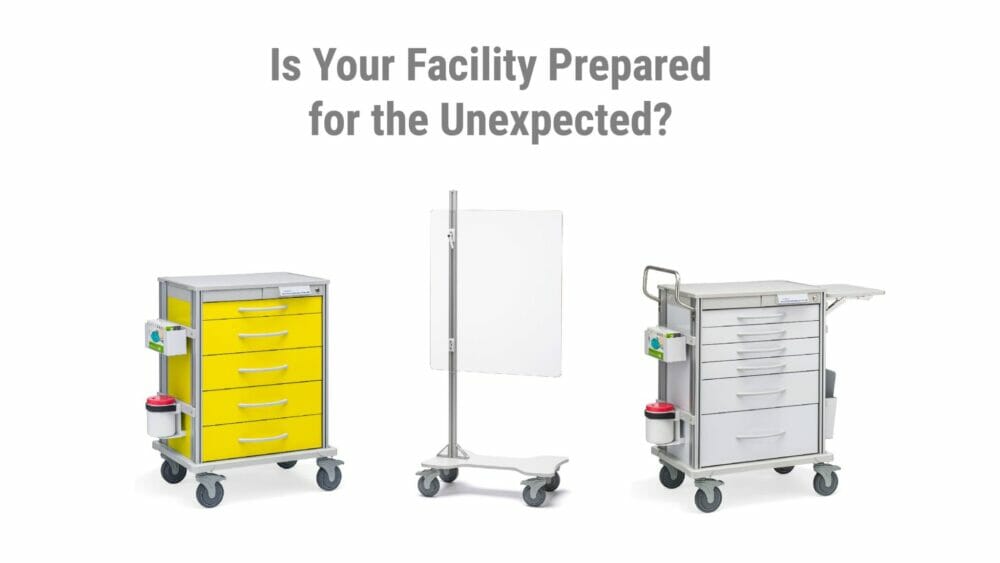
Now that the pandemic is waning, do you need those sneeze guards? Can hospitals reduce the number of isolation carts in circulation?
If you think your facility can finally return to normal, research suggests that you may want to continue to watch for respiratory virus outbreaks.
This article will examine the current “tripledemic” and how the pandemic made it harder to predict the timing of viral outbreaks. We’ll also review why facilities need adequate supplies and storage space to handle whatever the post-pandemic world throws at you.
The Tripledemic
In the fall of 2022, experts warned of a possible influx of people sickened with respiratory viruses. Respiratory Syncytial Virus (RSV), influenza, and COVID-19 cases rose from fall into winter, posing a threat to our already fragile post-pandemic healthcare infrastructure.
The Centers for Disease Control and Prevention (CDC) Respiratory Virus Hospitalization Surveillance Network shows that COVID-19 hospitalizations peaked at the end of December 2022. Before that date, flu hospitalizations peaked in early December, and RSV hospitalizations in mid-November.
The number of illnesses and deaths is declining. Yet, hospitals continue to see high case numbers. Also, current research shows that the pandemic threw off the seasonal timing of RSV outbreaks and the timing of other infectious diseases, making it difficult to predict future respiratory virus outbreaks.
Why Experts Are Concerned About RSV
RSV typically causes cold-like symptoms that subside after one to two weeks. But older adults and children less than one year old can develop severe infections.
The journal Infection and Drug Resistance reported that the number of RSV cases during the 2020-2021 fall/winter months was unexpectedly low. Researchers attribute this to the public health measures imposed by state and local governments, such as mask-wearing and shelter-in-place guidelines.
When public health measures were lifted during the summer of 2021, RSV case numbers rose. These warm weather outbreaks of RSV infections didn’t coincide with the usual fall/winter RSV surge.
Researchers noted that the higher-than-normal summer RSV infection rates could have been due to parents returning to work and people traveling to other countries. But research also showed that people’s immune systems could have been compromised by spending a year or more in isolation.
Our immune system needs exposure to pathogens (priming) to help it learn to fight those same pathogens in the future. The study’s researchers state that children and adults may have less immunity to RSV due to a lack of exposure during the pandemic.
Researchers found that babies born during the pandemic are more likely to contract RSV compared to babies and children born before or after the pandemic. Children are typically exposed to viruses when they are young. These early exposures help them develop some immunity. But this group of babies was not exposed early in their lives and are more susceptible to RSV.
While the tripledemic is losing steam, a recent American Medical Association (AMA) article reminds us that admissions related to respiratory viruses are ebbing and flowing at the community level. Hospitals need to stay prepared for viral outbreaks.
Prepare With The Right Equipment
Investing in high-quality medical carts, cabinets, and protective equipment can protect a facility’s investment in preparedness and help protect staff and patients by ensuring supplies are easily accessible.
Consider the roles of various storage and protective equipment during an infectious outbreak:
- Isolation carts can be assigned to separate isolation rooms or areas.
- Converting an area or set of rooms to isolation areas may involve stocking extra pharmacy carts.
- Stationary sneeze guards are now considered standard in areas where staff and visitors interact.
- Mobile sneeze guards provide flexibility when caring for hospitalized patients and speaking with caregivers at the bedside.
Studies have shown that healthcare facilities can no longer depend on seasonal variations of viral diseases. The AMA recommends “redoubling” efforts to prevent the spread of these respiratory viruses amid continuing community outbreaks. It’s worth remembering that COVID-19 is not the only virus affecting our healthcare system.
